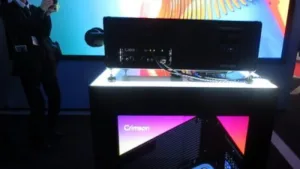 Christie Crimson projector with a side-shooting short-throw lens at ISE resting on a base with a 2 x 2 array of Christie MicroTiles providing information about the projector. (Credit: M. Brennesholtz)
Christie Crimson projector with a side-shooting short-throw lens at ISE resting on a base with a 2 x 2 array of Christie MicroTiles providing information about the projector. (Credit: M. Brennesholtz)
Christie Digital introduced its new Crimson Series of 3DLP laser phosphor projectors at ISE. The two members of the Crimson family are the Crimson HD25 with FHD (1920 x 1080) resolution and 23,300 lumens and the Crimson WU25 with WUXGA (1920 x 1200) resolution and 25,000 lumens. These projectors both have 2000:1 contrast, 60Hz processing, and Christie BoldColor Technology in a compact and rugged package. The units are said to provide a low cost of ownership for rental, staging and fixed installation customers. The Crimson series includes the ultra-fast processing of Christie TruLife electronics and built-in warp and blend capabilities of Christie Twist. The series was designed with the installer in mind and is said to be easy to ship, handle and install thanks to its compact form factor, quiet operation and 360º orientation. The projectors feature an IP5X sealed, solid-state laser light source. Christie says the Crimson Series is compatible with all existing J and M Series lenses, for companies that have those lenses in their inventories.
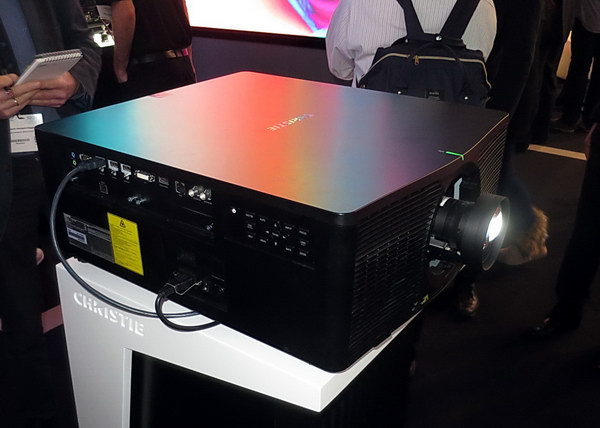 Christie 4K10-HS at ISE. (Credit: M. Brennesholtz)
Christie 4K10-HS at ISE. (Credit: M. Brennesholtz)
Christie was also previewing two upcoming members of the HS Series, the 4K10-HS and 4K7-HS with 10K and 7K ANSI lumens, respectively. Both, of course, are laser-phosphor based. These projectors are expected to be available mid-year. The two single-chip DLP projectors both have BoldColor, and achieve 4K resolution using pixel shift. BoldColor uses red and blue lasers and a green phosphor excited by blue lasers to produce red, blue and green respectively. Typically, this arrangement will produce DCI/P3 colorimetry but cannot produce true Rec. 2020. While BoldColor is not new and I saw it at ISE last year, it is still unfamiliar to many visitors to ISE and Christie dedicated a portion of it’s booth to showing exactly what the technology was and what it meant to end-users.
Christie also introduced the new Velvet CorePlus LED video walls. These are said to “deliver unparalleled design flexibility for a value-priced LED video wall solution. Ranging in pixel pitches from 1.2 to 4.0mm, the single architecture scales easily to popular resolutions including 4K, is fully customizable with remote and on-board options, and can be both installed and serviced from either the front or back.” Available Velvet CorePlus pixel pitches are 1.2, 1.4, 1.9, 2.4, 3.0 and 4.0mm.
The Velvet series is for indoor use, can be installed either flat or concave and, when installed flat on the wall, is ADA compliant. They have an output of 600 cd/m², a contrast of 5000:1, a 160° horizontal and 140° vertical viewing angle, an IP30 rating and a lifetime to 50% of 100,000 hours. They use LED drivers from Macroblock (see separate article in this ISE report). The Velvet series targets public spaces, casinos, theme parks, houses of worship, broadcast, control rooms, conference rooms and many other applications. The CorePlus direct mount system makes for quick and easy installation directly onto flat walls and allows for a narrow installed depth of less than 100mm. This eliminates the need for additional mounting structures and thereby further reducing total system cost. The new E600 videowall controller allows end users to easily scale to 4K at 60Hz.
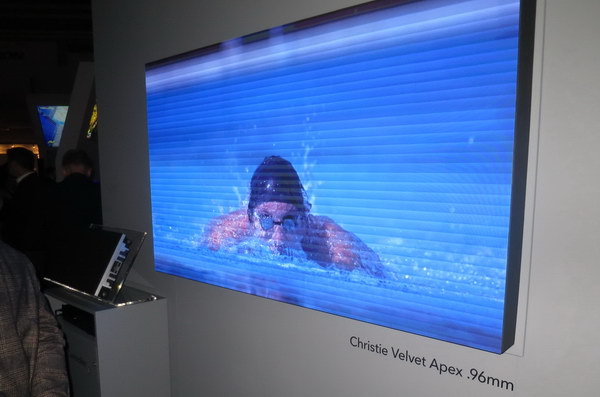 Christie’s new Velvet Apex 0.96 LED videowall. The image artifacts were not visible to the eye. (Credit: M. Brennesholtz)
Christie’s new Velvet Apex 0.96 LED videowall. The image artifacts were not visible to the eye. (Credit: M. Brennesholtz)
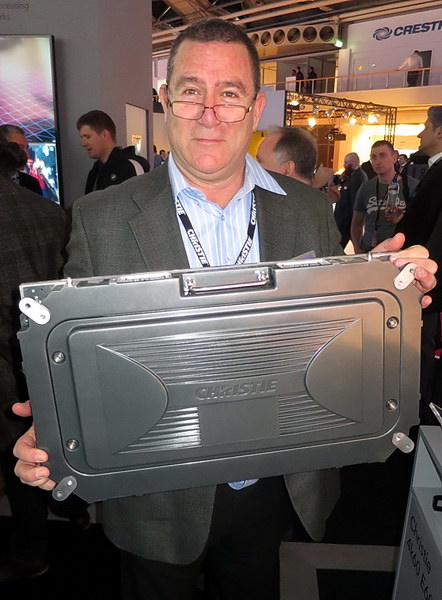 Christie’s Ron Gritzerstein shows the rear of a Apex 0.9mm LED module. (Credit: M. Brennesholtz)
Christie’s Ron Gritzerstein shows the rear of a Apex 0.9mm LED module. (Credit: M. Brennesholtz)
The Apex 0.9mm LED video wall is a new member of the Christie Velvet Apex Series and is also compatible with the E600 controller. The actual pixel pitch is 0.96mm, brightness is 800 cd/m², viewing angle is 160° horizontally and 140° vertically and the contrast is 5000:1. Lifetime is said to be 100,000 hours to 50% output and the unit can be used in 24/7 systems. Like other members of the Apex series, the Apex 0.9mm is designed for indoor use (IP30), can provide 4K60 resolution, is HDR10 compatible and all service is from the front. Existing Apex series modules have pixel pitches of 1.2, 1.6, 1.9 and 2.5mm. All modules in the Apex series feature a 16:9 aspect ratio, simplifying the display of 16:9 video content.
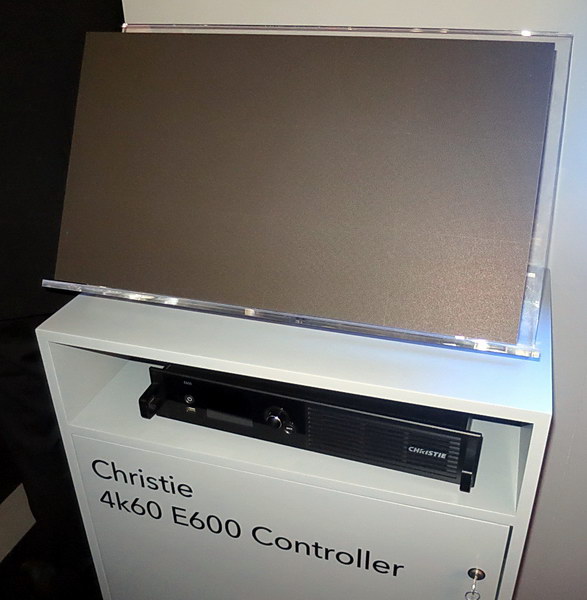 Christie’s new 4K60 E600 videowall controller and the front of a Apex 0.9mm LED module. (Credit: M. Brennesholtz)
Christie’s new 4K60 E600 videowall controller and the front of a Apex 0.9mm LED module. (Credit: M. Brennesholtz)
Christie also demonstrated its Terra lineup of products to ISE for the first time. Terra is Christie’s implementation of Software Defined Video over Ethernet (SDVoE) technology and includes an expanding series of transmitters, receivers, control hardware and software. Terra allows Christie to offer a complete native 4K, 4:4:4 content delivery solution, from player to display.
Christie Terra is built on standardized SDVoE technology and supports video formats up to 4K at 60Hz and provides end-to-end transport and processing of uncompressed, zero-frame latency, artefact-free video over affordable 10G Ethernet components. Christie is a founding member of the SDVoE alliance.
Christie has exited the rear-projection cube market for control rooms. I was told that with long life 0.96mm pitch LED videowalls and LCDs that can be tiled, the company does not feel the need to continue to produce RP cubes. They continue to sell MicroTiles, which also use DLP RP technology. These are generally used in applications such as museums, retail and on-set broadcast. While they were on display at ISE, the MicroTiles were not featured or even identified by signage. –Matthew Brennesholtz

